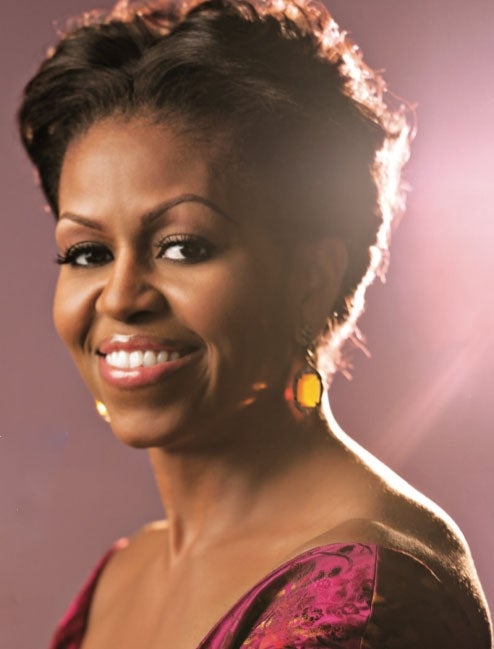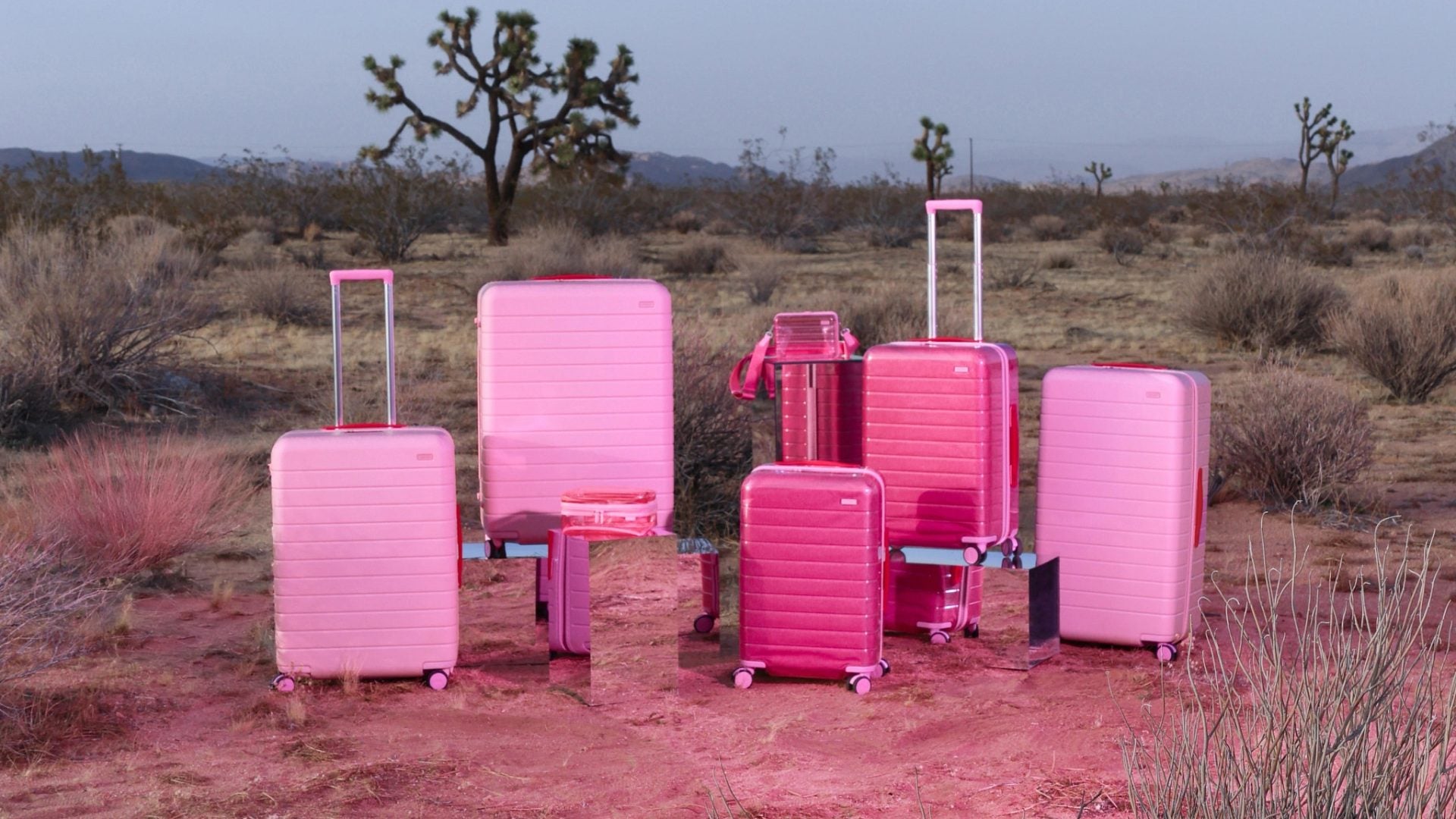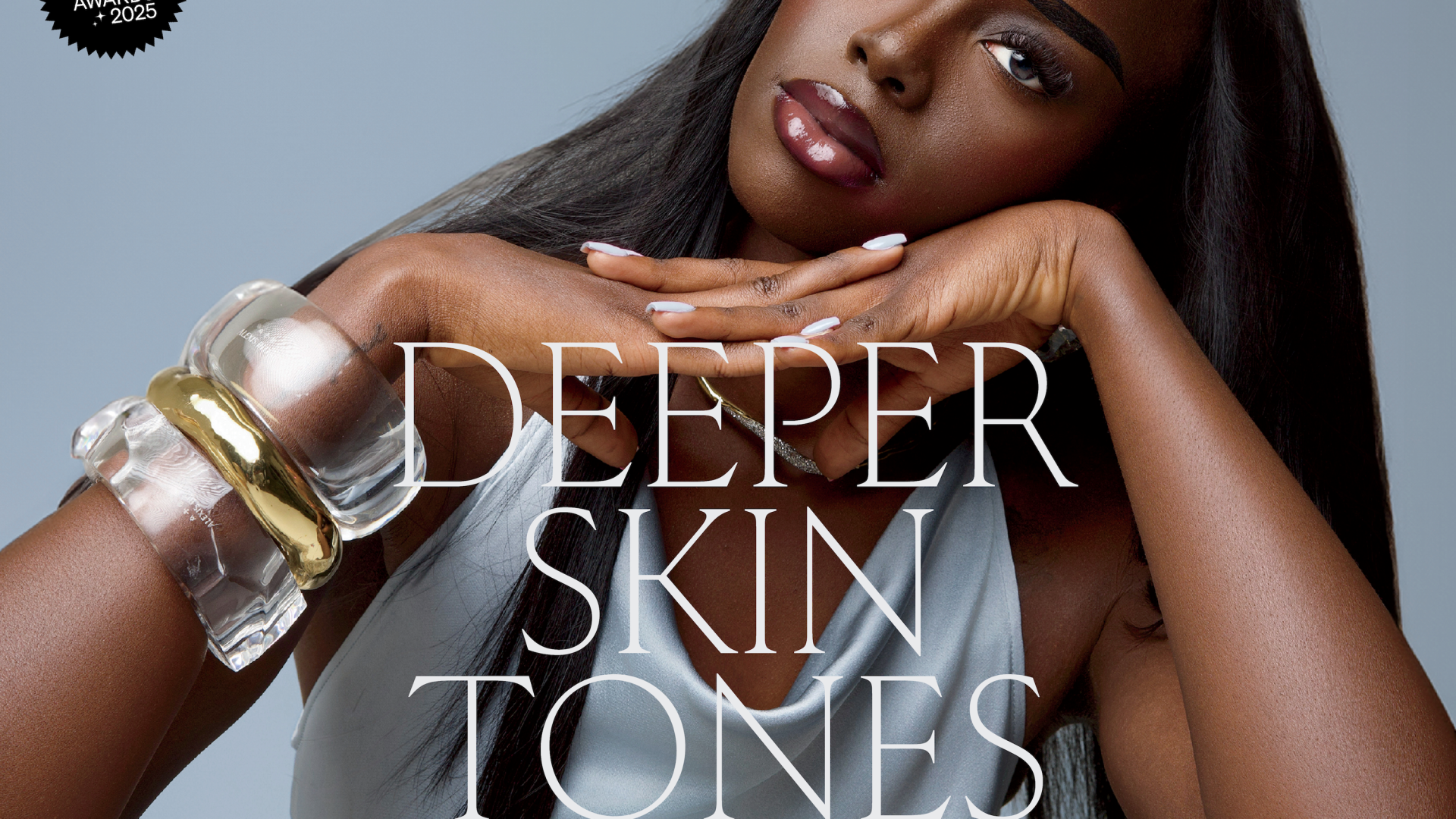
“Black women are hobbled by their strength and directness,” she told a Newsweek magazine reporter, speaking frankly about an issue familiar to African-American women everywhere. “I admit it: I am louder than the average human being and have no fear of speaking my mind. These traits don’t come from the color of my skin but from an unwavering belief in my own intelligence.”
Three years later, Mrs. Obama has effectively vanquished all attempts to define her based on antiquated ideas about what our First Lady should be. Living in the White House fishbowl, taking her place on the world stage as if she had been hosting state dinners her whole life, and speaking passionately about the challenge of childhood obesity and the plight of military families, she has shown us not only great strength and directness but also undeniable substance and enviable style. She provides a powerful symbol for a country still coming to terms with new ways of looking at race, class and gender. How could the future be frightening if it looked like Michelle Obama, smiling at us from her official portrait, in her tasteful black dress and her perfect pearls?
Difficult to measure but impossible to ignore, her power comes from a place of obvious authenticity. Even when the world is watching and judging and tweeting nonstop, Michelle Obama is never trying to be anybody but Michelle Obama. Who can forget her first post-election visit to the White House, when she wore that amazing red dress, looking like the heroine of a Langston Hughes poem? Don’t worry, she seemed to say . I can handle this!
We admire her confidence and always hope some of it might rub off on us. That’s why those famously toned arms can make us buy a set of weights, even if we never quite get around to using them. Why what we see of her marriage and family renews our faith in the possibility of grown-up love.
Wherever the camera catches her, she seems to be in the moment, finding her joy. Watching from the sidelines, we resolve to embrace her more fully, regardless of our own complicated lives and complicated country; confident that whatever it is, we can handle it because she can. — Pearl Cleage
In a singular scene near the end of her goodwill tour through South Africa and Botswana, First Lady Michelle Obama steps into an empty soccer stadium in Cape Town for a chat with the garrulous former Anglican Archbishop Desmond Tutu. After a few pleasantries, he’s bubbling over, asking “What do you feel?” and “How are you feeling about being here?” Without hesitation, Mrs. Obama gestures to her two daughters, a teenage niece and a nephew, all of whom have accompanied her on this weeklong African journey of personal pilgrimage and U.S. diplomacy. “It’s not about us now,” she says. “It’s about them.” Tutu nods with understanding.
A horde of local and international media and Secret Service agents surrounds her. White House staffers busily keep her on schedule. But Mrs. Obama talks to Tutu as if he were the only person there. Her focus is on the next generation, she explains to the archbishop. As if on cue, children begin pouring into the stadium, kicking soccer balls and running in between orange cones in games that teach them about HIV/AIDS prevention. Soon Mrs. Obama and Tutu join in the play, knocking around a ball and doling out high fives.
Issues facing children and families have been central to this visit, as well as an overriding theme during Mrs. Obama’s nearly three years in the White House. We have witnessed her deliberate use of her power as First Lady, a force she often calls a “big, bright light.”
“What I try to do is…stand in front of things that are more important than me, and then that light not only shines on me but on everything around me,” she says. “That’s one of the primary things that this position offers.”
Weeks later, as Mrs. Obama sits down for an exclusive interview with ESSENCE, she is still thinking about her emotional trip to Africa. Here, in one of her offices in the East Wing, she is clearly at home. The room—dominated by a stately wood conference table, personal photos of her children, a color lithograph by famed painter Jacob Lawrence and a built-in bookshelf with books on everything from healthful eating to Dr. Seuss—overlooks the colorful Jacqueline Kennedy Garden. The office is crowded with nearly two dozen members of her staffand photographers steadily snapping away. And then there’s the glam squad of stylists (hair, clothing, makeup), a constant presence that keeps her looking flawless. Yet amid the frenetic energy, the First Lady is relaxed and eager to talk about what ignites her intrinsic sense of power. “I start with my passion,” she begins. “The first thing I think about is, What do I really, truly care about? Because that passion, that caring, is going to translate into energy…. Then I try to think about leveraging power. So the next question is, What can I have a unique impact on? Obviously this role is first lady—but that was different when I was a vice-president at a hospital or when I was running a nonprofit organization…. I don’t operate well with symbolic power. So my question is always, What is the lasting effect of anything that I do?“
Teaching Her Girls About Power
As Michelle Obama became the world’s most visible African-American woman nearly three years ago, she promptly declared that her daughters would remain her top priority. We have seen her hosting sleepovers for Malia and Sasha in the White House and taking her daughters along on trips to Spain (with Sasha) and Brazil. At home we see her negotiating a normal life for her girls by insisting they make their own beds and by moving her mother, Marian Robinson, into the White House.
And there are more indications that she keeps it old-school. Back in Johannesburg, while the family toured former President Nelson Mandela’s archives, Mrs. Obama turned to Sasha matter-of-factly and said, “Pay attention. You’ll be tested on this.” Before the visit to South Africa, she and her husband explained the history of the apartheid movement to their daughters, she says. But the trip made the stories real for them, as they met Mandela and learned of the movement’s martyrs, who gave up their lives protesting South African racial oppression.
She also never shied from how historic the trip was for her and for our country: someone whose African ancestors came to America as slaves, traveling to the continent as a First Lady. And by her side? The women she cherishes: “One of the most beautiful aspects of my trip to Africa was the fact that there were three generations of us there. It was me, my two little girls and my mom. Because there’s always… something different that comes with the experience. You can talk about the apartheid movement. I could have my girls read books about it. We talked extensively about Nelson Mandela and what his legacy meant. But it has much more power when you’re sitting in the Regina Mundi Church or you’re walking through the Apartheid Museum or you’re talking to the sister of [martyr] Hector Pieterson. Those stories really resonate with young people. So exposure for my girls is critical, and this trip was one of those unique opportunities.”
Such experiences are one of the ways Mrs. Obama is teaching her daughters about their own power. In the Obama household, conversations about responsibility and influence started early. “We talk endlessly, me and my girls, because I think that is also our power as women,” Mrs. Obama says. One point of discussion is the value of being prepared. “When you’re 7, what does [power] mean? It means you’ve got to do what you say you’re going to do. You have to take on responsibilities and chores, and you have to accomplish those small tasks to the fullest. You have to tell the truth. You have to be an honest person. You have to be good in how you engage with other people and how you develop your own friendships. All of that is the practice of power.”
Mrs. Obama’s older brother, Craig Robinson, who coaches basketball at Oregon State University, says their parents imparted similar life lessons to him and Michelle. “When I see the things she disciplines her kids about, like bedtime and homework, it just reminds me of the kitchen table at our house,” says Robinson. During the First Lady’s mentoring sessions with high school students from poor communities, whether in Washington, D.C., or Oxford or Cape Town, she usually tells the students about her parents. Her mother was a homemaker who later became a bank secretary, and her dad, Fraser Robinson, was a Chicago water-department employee who hardly ever missed a day of work despite being diagnosed with multiple sclerosis. Mrs. Obama describes herself as a straitlaced, ambitious kid who had plenty of self-doubt as she entered Princeton University’s Ivy League walls. “I wondered whether I could really keep up with the students whose parents had graduated from some of the finest universities, students who grew up with all the advantages I never had,” she tells about 50 students in Cape Town. “But once I got into the school and started meeting people—and attending classes and opening my mouth and exercising my brain—I realized I was doing just as well and, in many cases, even better than so many of my classmates.”
This is her message to them, that success is not about where you come from or how much money your family has. “My story to young people around this country and around the world is, Don’t look at me as the First Lady first; look at me as Michelle Obama, a girl who grew up on the South Side of Chicago. Because I was there, and this is attainable,” she says. “There is no magic to this. It is hard work.” And, she adds, you need to find a network of people who will embrace you.
Mrs. Obama almost always ends her talks with students with a literal embrace. She sometimes spends more than 20 minutes giving hugs to every child who approaches her. “They’re nervous,” she says. “And sometimes the best way to break that is just to give them a hug, because that’s ultimately what we all can relate to and we can all connect to, regardless of our race, our gender, our ethnicity, our geographic location.”
Living an Authentic Life
When the nation first met Michelle Obama, she was the wife of the only Black U.S. senator, the mother of two young daughters and a high-powered executive in Chicago. Her husband had to do a lot of persuading to convince her that his run for office would be the right thing for their family, she says. Meeting regular folks one-on-one during the early days of his campaign and hearing their stories eventually brought a change of heart. But in a political landscape where a Black person had never been elected president, a prototype did not exist for a Black first lady. So she began to deliberately carve out a role for herself .
She focused on military spouses and was able to speak so compassionately about them because of the empathy she felt for the military families she met while campaigning. She focused on mentoring, bringing young women to the White House for daylong guidance sessions where she tries to inspire them with her own journey. And, perhaps most famously, she focused on eating healthily. We’ve seen her doing push-ups with Desmond Tutu and jumping Double Dutch in her Let’s Move! campaign to reduce childhood obesity, as well as planting fruits and vegetables in the White House kitchen garden. She does this because she knows the challenges of raising healthy kids while holding down a full-time job. Mrs. Obama kicked her obesity campaign up a notch this summer, scoring a coup by securing commitments from Walmart, Walgreens, Supervalu and other retailers to open or expand more than 1,500 stores in communities that lack access to fresh produce and other healthy foods.
Her vision and drive have impressed longtime observers of national politics. “I see a First Lady who’s skillfully using her office with great political wisdom,” says Congresswoman Eleanor Holmes Norton, who has served in Washington, D.C., since the 1970’s and seen six first ladies occupy the White House. “She has involved herself in policy that is deeply consequential to the American people but noncontroversial to all except the fringe.” Donna Brazile, the veteran Democratic political strategist, says that like most first ladies, Mrs. Obama plays a unique role as both the spouse to the President and an accomplished leader in her own right. “She can use her popularity to help the President get his message across to many without looking partisan,” Brazile says. “Let’s face it: When the First Lady moves, we are all in sync.”
Investing in Self
The First Lady’s Secret Service code name is Renaissance. It is a word with layers of meaning. She has gone from apolitical to a political icon. She has the aura of an everywoman while wielding the power of a First Lady. “She does it very quietly, very effectively, very consistently,” says Harvard professor Charles Ogletree, who saw the same traits when he mentored a young Michelle Robinson in the 1980’s while she volunteered for the university’s legal-aide clinic. It’s all working for her: Polls show 66 percent of Americans view her favorably, which is about 20 points higher than the President’s rating.
Already raising money for her husband’s reelection, White House aides and Democratic strategists are counting on the First Lady’s appeal with voters to help spur her husband’s 2012 campaign. As things kick into high gear, Mrs. Obama says she refuels her spirit by staying connected to a small group of girlfriends with whom she makes time for dinners out in Washington, D.C. “This is to all our ESSENCE women: You’ve got to force yourself to take time for yourself, period,” she says. “As women, we have to put ourselves higher on our own priority lists. That means, for me… taking that time to rejuvenate; taking the time every day to exercise; taking the time to go out for dinner with a girlfriend.
“Women energize me,” she continues. “My husband is terrific. He is my true partner. Spending time with him is key…. But it’s also important for us as women to find each other. And there’s that natural reenergizing that happens when women get together. We kind of hold each other up.”
Mrs. Obama has unapologetically found the work–recreation balance that twenty-first-century women crave. “I think all of us, as Black women, as women generally, we need to tap into that investment in ourselves,” she says. “We have to be more okay with that. Because if we don’t have the energy, we can’t pass it on. I learned it from watching my own mother not invest in herself, for example. She’s starting to do that. But she came from the tradition of family first. She wouldn’t even go to the hairdresser on a regular basis. I want to show my girls that it is perfectly fine to invest in yourself and to start to do it early, embrace it and not feel guilty about the time we put into ourselves.” As our time with her ends, Mrs. Obama’s staff begins ushering her to her next appointment: shooting a public-service announcement on reducing childhood obesity for Nickelodeon. She is always on the go, and while she’s in the moment, it’s also clear that she’s already looking beyond 2012. While Mrs. Obama was in Johannesburg, Mandela’s wife, Graça Machel, who is a humanitarian and former first lady of Mozambique and South Africa, told her that she is eager to see what she and her husband do after his presidency. “It just made me think even more broadly…. Yes, there is power in the office, but there is also power in the potential of the future,” Mrs. Obama says. “This is really just the beginning, and it should be for all of us.”





